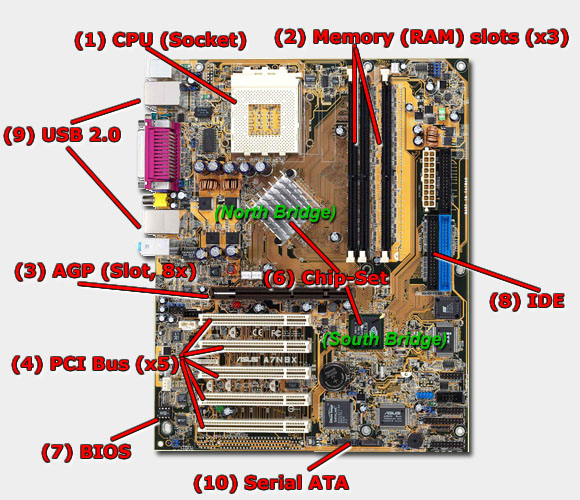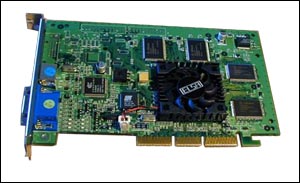Daniel Sevo's PC buyers guide
Section 2: The hardware explainedYou get what you pay for, or do you?Click on the words that are linked to get an explanation of what it means... As I mentioned earlier, people who are not familiar with hardware only look at the obvious numbers. CPU MHz, size of the Hard drive & RAM. These numbers are often presented in the ad for the product. What you often don't see is what kind of graphics card you get. Many PC manufacturers that target the casual user will offer PCs with integrated graphics. What this means is that the graphics are integrated into the chip-set on the moderboards, so there is no separate graphics card attached. These solutions typically use a portion of system RAM as graphics memory. While the integrated solutions have become much better the last few years, they are nowhere as good as a dedicated graphics card. Still, for people who mostly use their PCs for other things than playing the latest games, an integrated solution may be a wise choice as it will save you money and you can usually add a graphics card later on if you would change your mind. Before we go on and talk about specific hardware, I would like to briefly explain the the different components that the computer consists of. Here is a picture of what was a State-of-the-art motherboard sold in late 2002. While some features change, it is more than enough to explain 'the big picture'. 
The motherboard is the base for every computer. This is where you attach all the other components. The numbers explained:
As you can see, there are quite a few components required for a complete computer system, so the number of possible combinations of these components is huge! Some motherboards have chipsets that include graphics -or sound functionality. This is obviously to save money, so the computer can be sold without an external graphics card. While this is a good way of cutting overall cost of a computer system, it is rarely a very good solution for gamers. If you do not play games or do any serious graphics work, this might actually save you a couple of bucks. The same applies for those chip-sets that have sound capabilities built in. To cut prices many dealers sell computers with embedded graphics (mentioned above). The ad will probably say '3D graphics, 8Mb shared with the main memory' or something. What this means is that parts of the main memory are used as 'graphics memory'. This is another reason why this solution is much cheaper than a separate GFX card which has it's own graphics memory. However, nVidia's nForce chip-set is a new high-performing chip-set with an integrated graphics core. Given nVidia's experience with graphic chips, this integrated solution may outperform some 'real' graphics cards. More about this in the next section. So how about the other components? 
The casing should be a MID-tower. MINI tower systems are often impossible to expand. HIGH-tower cases are only recommended for enthusiasts that want to expand their computers gradually. Normally a case has a 400W power supply unit (PSU). These days, the CPU, GFX card, hardDrives draw a lot of power, so you should try to get 450W-500W or more if you are building a 'state-of-the-art' system (I use 500W). 
The monitor, the computer screen, is an important part of you set-up. Nowadays 19in are cheap so there is no reason to buy anything smaller (such as 15in) although, for many people a 17in will do fine (although I really recommend you add a few extra bucks and get a good 19"). For a technical overview of CRT monitors and how they work, click here. Remember, the Monitor is likely to be the part of your computer set-up that will keep the longest, so make sure you don't get 'cheap' when you buy a monitor - you will probably regret it later. After 3 years when your computer stars feeling like a dead snail, the monitor will be the only thing that isn't hopelessly out of date. Obviously, the older CRT monitors are still cheaper than the new thin LCD screens, so before you buy you might want to consider several issues. Such as available space on your desk (big CRT monitors obviously require a lot of space). People who are sensitive to electromagnetism and can actually sense the weak electromagnetic radiation from CRT screens also prefer LCD screens. The most important issue fro gamers and professionals will be the ability to reach high screen resolutions and good refresh rate. As I said before, I discuss these topics here. Unless you buy the most expensive LCDs on the market, a CRT screen will still offer higher resolutions and better responsivness. (Personally i use a screen resolution of 1920x1440 on my 19in CRT screen. Not many LCD screens will be able to achieve such high resolutions.) 

Most computers come with a ~160GB (GigaByte) or larger HD these days, but Harddrive-space is typically something you can never have too much of. The rule here is to buy the largest HD you can afford. (I have 690GB+ in my computer at home) It should support at least ATA 100/ATA133. All new computers have support for Serial ATA, so you should consider this option (All my HardDrives are SATA, I use my IDE controller for DVD players/burners). One additional note in this case is solely based on my experience with certain brands. My intention is not to point out some specific brand just because I happen to like it, but still, here's the deal. I've had many different HD brands over the years and some of them have functioned better than others. Personally I've had HD crashes with IBM, Quantum, WesternDigital, Fujitsu & Seagate drives. One brand that I have used for extensive periods of time and has NOT resulted in any HD crashes is Samsung. (I've also owned Arial & Conner HDs but for short periods of time only.) Still, the 4 Seagate Serial ATA drives I currently have in my system work fine (so far). 
The memory market is perhaps the most annoying of them all. Memory prices go up & down like a roller-coaster. These days, the most common are 400Mhz DDR SDRAM and possibly slightly faster DDR2. (Older Intel CPUs required RDRAM so 800MHz RDRAM RIMMS were quite common.) The best option at this point (year 2005) depends a little on which brand CPU you want (more about this in the next section). Generally speaking 400MHz DDR SDRAM is cheap and commonly available. However, the future might lie with DDR2 so if you want to buy a lot of memory which you later want to transfer to your next computer, you might want to buy DD2 memory. You will need to check what kind of memory your motherboard/chip-set supports. If you're buying a new Intel system, then you might want to buy 533MHz DDR2 memory. Most Athlon systems (both 64 and XP) will do fine with 400MHz DDR1 for now. (Note: Older SDRAM uses a 168-pin interface, while DDR SDRAM uses 184-pin. So they aren't pin compatible, meaning you can't use your old SDRAM on a mainboard that is designed for DDR SDRAM.)
[Some pictures might be borrowed :) from www.anandtech.com]
Section 3: Categories 5 & 6. Demanding hardware. Section 4: Links to other buyers guides. |

Return Home |